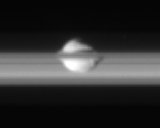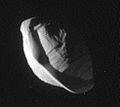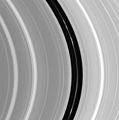Pan (moon) facts for kids

Pan amid the rings of Saturn. The 'side' view gives Pan the appearance of being embedded in the rings, although it actually travels within the Encke Gap.
|
|
| Discovery | |
|---|---|
| Discovered by | M. R. Showalter |
| Discovery date | July 16, 1990 |
| Designations | |
| Adjectives | Pandean |
| Orbital characteristics | |
| 133,584.0±0.1 km | |
| Eccentricity | 0.0000144±0.0000054 |
| 0.575050718 days (13.801217 hours) | |
| Inclination | 0.0001°±0.0004° |
| Satellite of | Saturn |
| Physical characteristics | |
| Dimensions | 34.4 × 31.4 × 20.8 km |
|
Mean radius
|
14.1 ± 1.3 km |
| Mass | 4.95 ± 0.75 ×1015 kg |
|
Mean density
|
0.42 ± 0.15 g/cm³ |
| 0.0001–0.0018 m/s2 | |
| ~0.006 km/s | |
| synchronous | |
| zero | |
| Albedo | 0.5 |
| Temperature | ~78 K |
Pan is a small moon that orbits the giant planet Saturn. It is the closest moon to Saturn, circling about 133,600 km above the planet's cloud tops. Pan was discovered in 1990 by a scientist named Mark Showalter. He found it by carefully looking at pictures taken by the Voyager 2 spacecraft.
This tiny moon orbits inside a clear space in Saturn's A Ring, called the Encke Gap. Pan helps to keep this gap open. The moon was named after the Greek god Pan on September 16, 1991. It is also known by its scientific name, Saturn XVIII. Pan's mass is about 4.95 x 1015 kilograms.
Discovery of Pan
Pan was discovered on July 16, 1990, by Mark Showalter. He was studying old images taken by the Voyager 2 probe. This probe flew past Saturn in 1981. Showalter noticed a small, faint object in the Encke Gap.
Scientists had already guessed that a moon must exist in this gap. They knew something was keeping the gap clear of ring particles. Pan was exactly what they were looking for.
Pan's Orbit and the Encke Gap
Pan orbits Saturn within the Encke Gap. This gap is a 325-kilometre-wide space in Saturn's A Ring. Pan acts like a "shepherd moon." It uses its gravity to clear out the ring particles. This action helps to keep the Encke Gap open and clear.
The moon's orbit is very close to Saturn. It takes Pan about 13.8 hours to complete one trip around the planet. This is a very fast orbit compared to Earth's moon. Pan's orbit is also almost perfectly circular and flat.
Shape and Features
Pan has a very unusual shape. It looks a bit like a walnut or a flying saucer. This is because it has a noticeable ridge around its equator. This ridge is made of ring material that Pan has collected over time.
The moon is not perfectly round. Its dimensions are about 34.4 by 31.4 by 20.8 kilometres. Pan's surface is likely covered in icy particles. These particles come from Saturn's rings.
Images for kids
See also
 In Spanish: Pan (satélite) para niños
In Spanish: Pan (satélite) para niños







